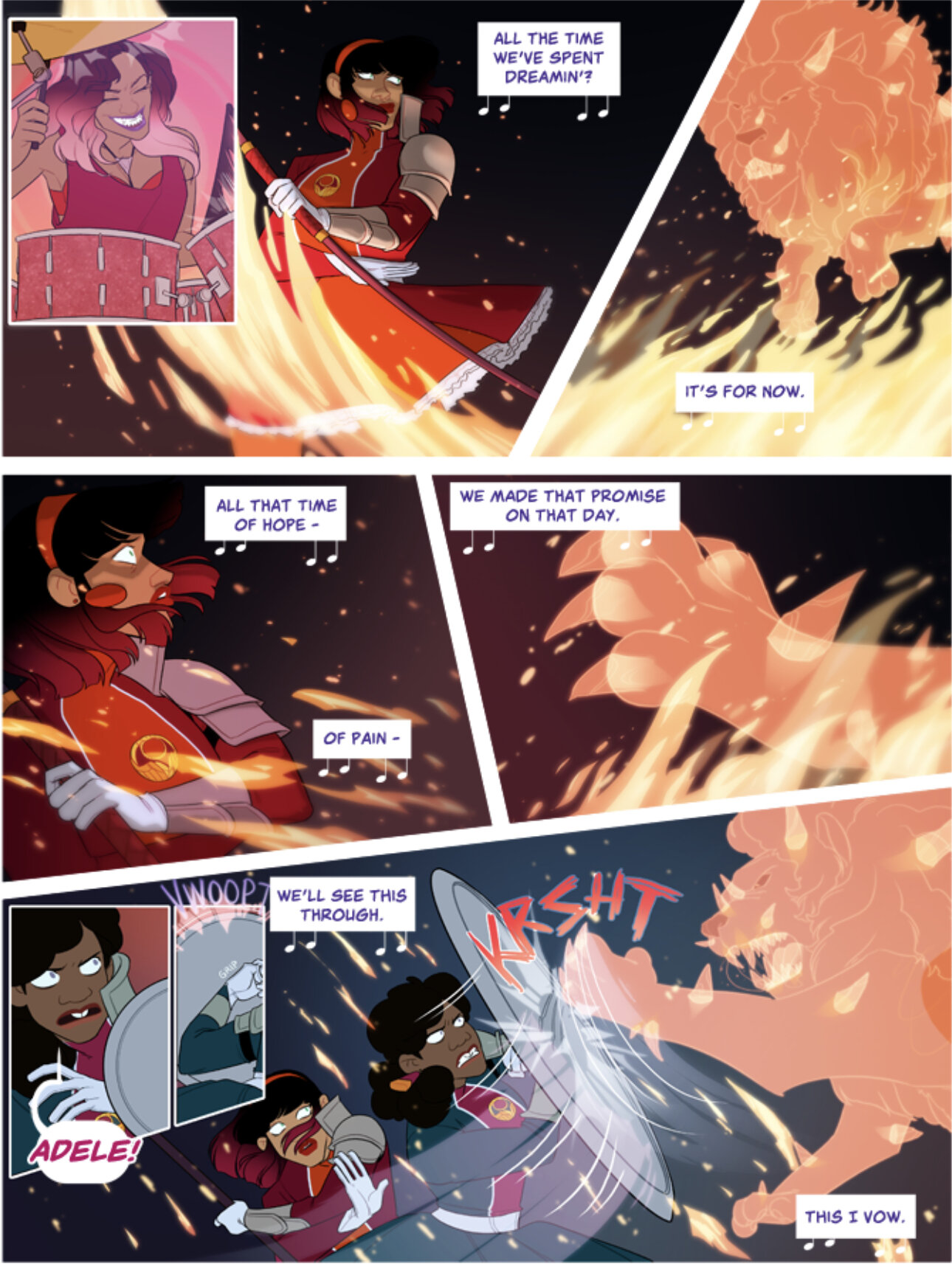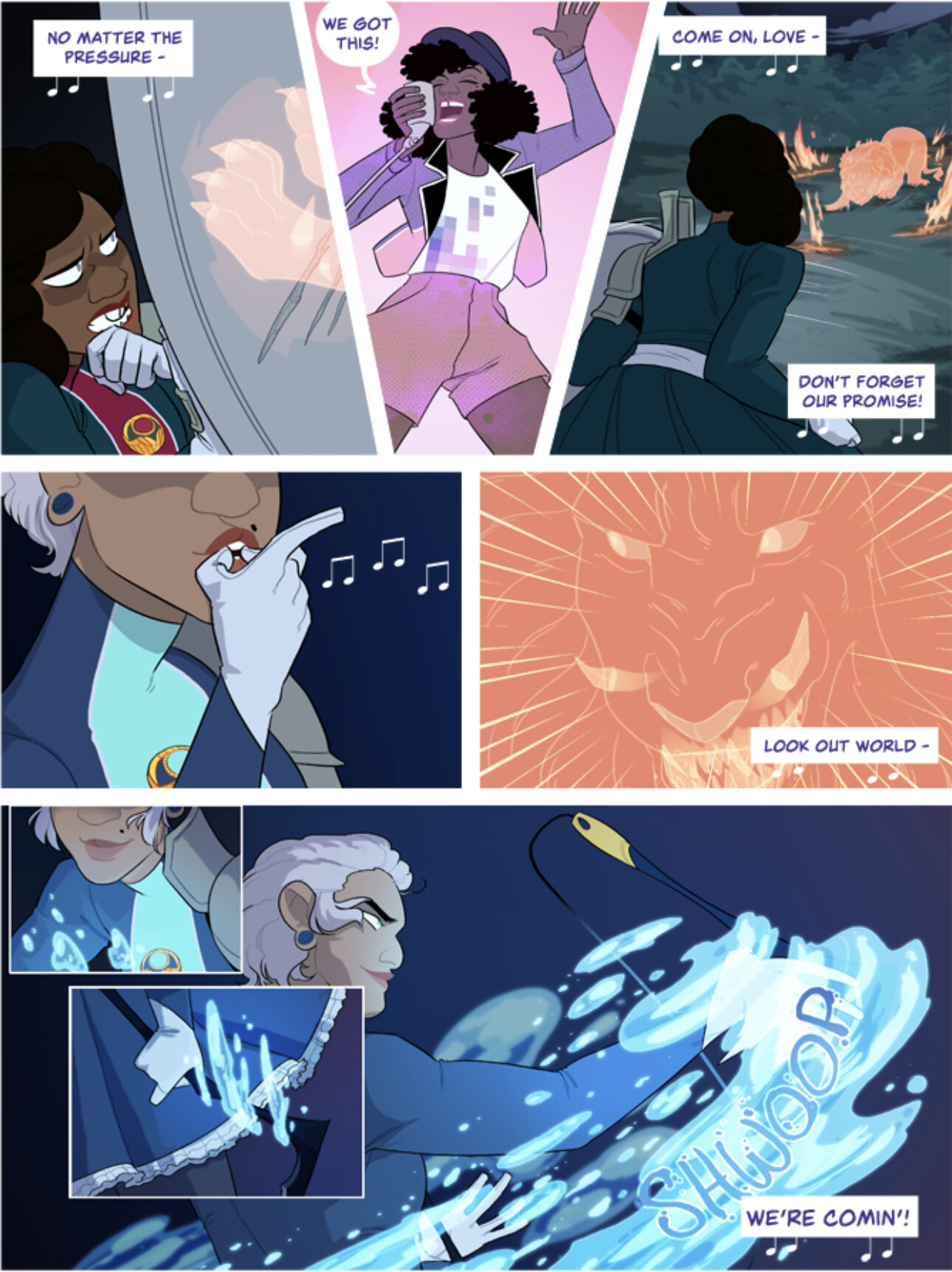Agents of the Realm by Mildred Louis is the story of five college students — Norah, Adele, Paige, Kendall, and Jordan — who learn they are the latest generation of Agents tasked with protecting a gateway between worlds. With its coming-of-age female protagonists, magical transformation sequences and powers, and underlying theme of fate, this comic falls neatly (and intentionally) into the genre of magical girls.
How does the fight/concert scene play with the reader’s senses and experience?
Call it cheesy, call it manipulative, call it whatever, but no one can deny the wide gamut of emotions a scene can generate when set to the right music. Musical accompaniment is not a new development by any means as theater has always relied on music to compliment the conveyance of feelings and to set the desired tones for the audience. As its artistic offspring, film continued to do so even during its earliest days. Keep in mind that silent films were only silent in terms of dialogue; music was always there as an active component. Today, theater, film, television, and video games feature elaborate soundtracks and scores that often are art in and of themselves. They strive to beautifully frame the action taking place engaging with our two most important senses. However, can this synchronicity be replicated through a single sense?
Credit: Mildred Louis
A five-panel page.
First panel: The Agents stand together, summoning their weapons from their brooches.
Imani Q (off-panel): Take my hand. And we’ll rush the horizon.
Second panel: A close-up of Imani Q singing.
Imani Q: We’ll storm the shores.
Third panel: A close-up of Imani Q’s guitarist, winking.
Imani Q (off-panel): Take anything in our way!
Fourth panel: Aclose-up of a fiery lion.
Imani Q (off-panel): We’ll take the whole world on —
Fifth panel: A group shot of the Agents as they face the fiery lion.
Imani Q (off-panel): And bask in the new day!
Just like its components of writing, drawing, and painting, comics are a purely visual medium. It seems like an obvious statement, but this is in regards to a medium that is also full of text in the shape of speech and thought bubbles, text boxes and visual sound effects. Comics are simultaneously full and devoid of sound; the experience of reading them manages to bridge that paradox, though. In this fight scene, there are two layers of sounds and voices: those of the fight and those of the Imani Q concert. They both take place at the same time and overplayed so the concert supplies the fight with a music track. This is the effect the creator wanted to achieve, and the reader’s experience with soundtracks and scores in other mediums allows this juxtaposition to be read as so, as a cinematographic fight scene in comic form. It is a great example of the blurring of lines between artistic mediums.
Credit: Mildred Louis
A five-panel page.
First panel: Adele summons some flames with her polearm. A smaller panel shows Imani Q’s dummer back on stage.
Imani Q (off-panel): All the time we’ve spent dreamin’?
Second panel: The fiery lion is running towards Adele.
Imani Q (off-panel): It’s for now.
Third panel: A close-up of Adele, weapon in hand, looking scared.
Imani Q (off-panel): All that time of hope — of pain —
Fourth panel: A close-up of the fiery lion’s paw.
Imani Q (off-panel): We made that promise on that day.
Fifth panel: In two smaller panels, Norah calls out to Adele and stops something with her shield. In the main panel, Norah swooped in between Adele and the lion with her shield.
Norah: Adele!
Imani Q (off-panel): We’ll see this through. This I vow.
Credit: Mildred Louis
A six-panel page.
First panel: A close-up of Norah pushing back the lion with her shield.
Imani Q (off-panel): No matter the pressure.
Second panel: Imani Q is singing on stage.
Imani Q: We got this!
Third panel: A rear shot of Norah as the lion jumped back to the far end, facing her.
Imani Q (off-panel): Come on, love — don’t forget our promise!
Fourth panel: A close-up of Jordan from the eyes down as she whistles at the lion.
Fifth panel: A close-up of the fiery lion.
Imani Q (off-panel): Look out world —
Sixth panel: Two smaller panels show Jordan charging up an attack. The main panel shows Jordan releasing her attack.
Imani Q (off-panel): We’re comin’!
As for the song itself, the lyrics work in unison with the action by both describing and complimenting it. This technique isn’t new, but it’s done well because it illicits the emotional beats needed to immerse oneself in the scene. The juxtaposition of the words “pain” followed by a fiery lion claw, of the word “pressure” and the tension between the lion and Norah’s shield, of the lyric “We’re coming’!” and Jordan unleashing an attack fools the mind into imbuing these silent pages with vibrant sound. There’s a degree of synethesia that occurs when reading comics — the perception of one sense through another. Colors and shapes become sounds, and in the case of the Agents, their first fight as a complete team set against the performance of an all-female band makes the Girl Power and Black Girl Magic pour right out of the page.


